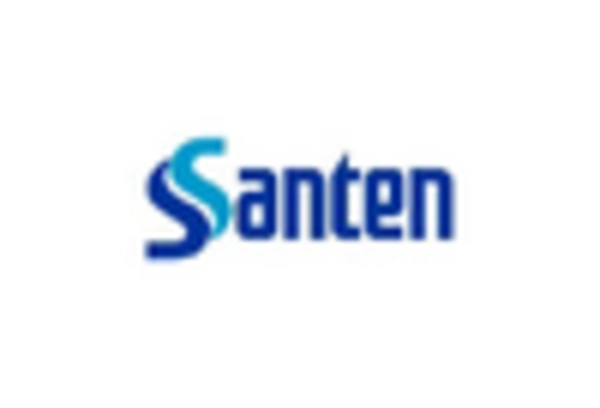Increasing Aging Population
The aging population in South Korea is a crucial driver for the retinal drugs market. As individuals age, the prevalence of age-related retinal diseases, such as age-related macular degeneration (AMD) and diabetic retinopathy, tends to rise. According to recent statistics, approximately 15% of the population aged 65 and older is affected by some form of retinal disease. This demographic shift is expected to lead to a growing demand for effective retinal treatments, thereby expanding the market. The retinal drugs market is likely to experience significant growth as healthcare providers focus on developing innovative therapies tailored to this aging demographic. Furthermore, the increasing life expectancy in South Korea suggests that the number of individuals requiring retinal care will continue to rise, further propelling the market forward.
Rising Healthcare Expenditure
In South Korea, increasing healthcare expenditure is a significant driver for the retinal drugs market. The government has been investing heavily in healthcare infrastructure and services, which has led to improved access to advanced medical treatments. In 2025, healthcare spending is projected to reach approximately 9.5% of the GDP, reflecting a commitment to enhancing patient care. This increase in funding allows for the development and distribution of innovative retinal drugs, making them more accessible to patients. The retinal drugs market stands to gain from this trend, as higher healthcare budgets facilitate research and development efforts, ultimately leading to the introduction of new therapies. As the population becomes more aware of available treatments, the demand for retinal drugs is expected to rise, further contributing to market expansion.
Growing Awareness of Eye Health
The rising awareness of eye health among the South Korean population is a notable driver for the retinal drugs market. Public health campaigns and educational initiatives have been instrumental in informing individuals about the importance of regular eye examinations and early detection of retinal diseases. This heightened awareness is likely to lead to an increase in patient consultations and subsequent demand for retinal treatments. The retinal drugs market is expected to benefit from this trend, as more individuals seek medical advice and treatment options for their eye health concerns. Furthermore, as awareness continues to grow, it may encourage further research and development in the field, leading to the introduction of new and effective therapies for retinal diseases.
Supportive Regulatory Environment
The regulatory environment in South Korea plays a pivotal role in shaping the retinal drugs market. The government has established frameworks that facilitate the approval and commercialization of new retinal therapies. Regulatory bodies are increasingly prioritizing the review of innovative treatments, which can expedite their entry into the market. This supportive stance is likely to encourage pharmaceutical companies to invest in research and development for retinal drugs. The retinal drugs market is expected to thrive as a result of this conducive regulatory landscape, which not only fosters innovation but also ensures that patients have timely access to new therapies. As regulations continue to evolve, they may further enhance the market's growth potential.
Advancements in Medical Technology
Technological innovations in the field of ophthalmology are significantly influencing the retinal drugs market. The introduction of novel drug delivery systems, such as sustained-release implants and targeted therapies, enhances the efficacy of treatments for retinal diseases. For instance, recent advancements have led to the development of biologics that can be administered less frequently while maintaining therapeutic effectiveness. This shift towards more efficient treatment options is likely to attract both healthcare providers and patients, thereby stimulating market growth. The retinal drugs market is poised to benefit from these advancements, as they not only improve patient outcomes but also reduce the overall burden on healthcare systems. As technology continues to evolve, the potential for new therapeutic modalities will likely expand, further driving the market.

















Leave a Comment